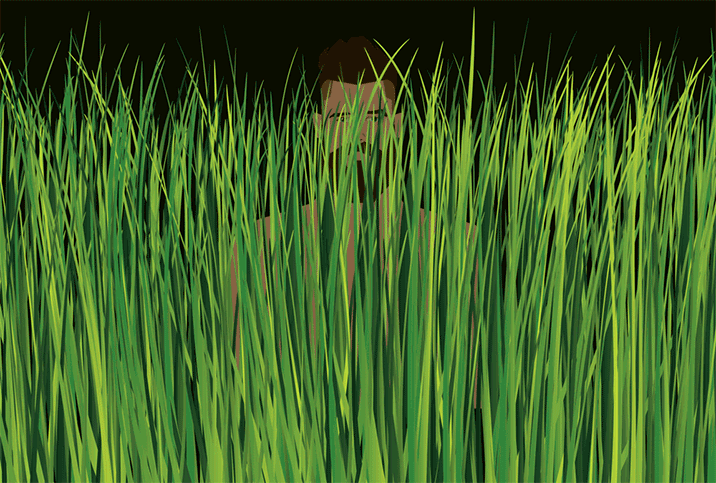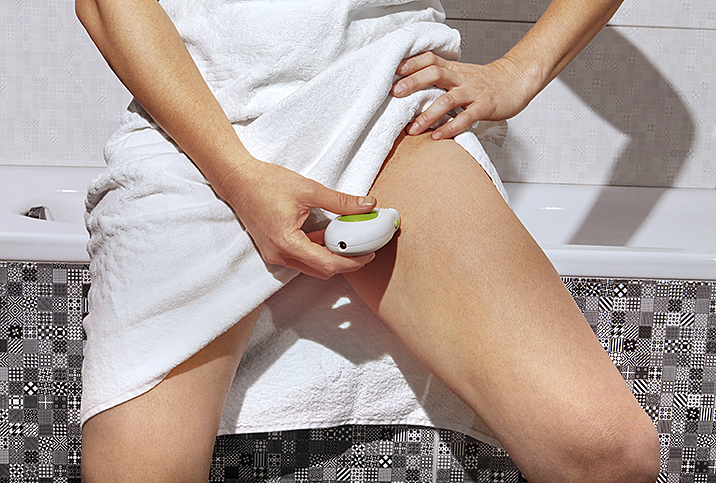Some Like It Hairy: A History of Pubic Grooming

On their wedding night in April 1848, the famously erudite art critic John Ruskin was reportedly so shocked to discover the pubic hair of his beautiful young bride, Euphemia "Effie" Gray, that he refused to consummate the marriage.
"Though her face was beautiful, there were certain circumstances in her person," Ruskin wrote, that rendered him unable to do the deed.
No one but Ruskin knows what those "certain circumstances" were, but the prevailing, popular interpretation is that he was referring to Effie's pubic hair. The theory was introduced by Ruskin's biographer, Mary Lutyens, who speculated that Ruskin was repulsed by the sight of his teenage wife's pubic hair because he had, until then, seen only hairless female bodies in paintings and sculptures of the time.
Whether this commonly proffered explanation is fact or folklore, it's a familiar story. From classical paintings to Playboy spreads, depictions of the body in media have long influenced our perspectives of pubic hairstyle standards—especially those for women.
According to clinical therapist and sex educator Jet Setting Jasmine, human civilization's preoccupation with pubic hair—or lack thereof—borders on obsession.
"Think about all different styles of waxing, or how if you go to the pharmacy, there's a whole aisle on hair removal, hair trimming, hair softening and hair lightening," she said. "When I see how much time and attention we give to pubic hair in our culture, it tells us how important it is for how people feel and how people feel they are received."
Not just important but ever-evolving, too; civilization's pubic beauty standards have morphed over time, and continue to do so. It seems like only yesterday that the media was lamenting the demise of American women's pubic hair, and now it's calling for its triumphant comeback.
But our preoccupation with pubic hair is no modern phenomenon; rather, it's one that dates back to the beginning of recorded history.
The Stone Age: Clamshells and shark teeth
Archeologists believe it was our cavepeople ancestors who kicked off the trend of shaving pubic and other bodily hair—though not for vanity reasons. Rather, prehistoric evidence suggests Stone Age-era humans used clam shells, shark's teeth and sharpened flints to shave hair from their bodies to avoid frostbite caused by water being trapped and frozen in their hair.
Ancient Egypt: Waxing
Egyptians were among the first to popularize the cosmetic removal of body hair, which they viewed as uncivilized and dirty. In addition to using tools such as seashells and pumice stones, ancient Egyptian women relied on an early waxing hair-removal technique known as sugaring, where a sticky paste made from sugar, water and lemon juice was used to yank out body hair.
Ancient Greek and Roman empires: Singeing and plucking
To infer how Greek male sculptors felt about pubic hair on women, you need only look at the smooth, hairless crotch region on a statue of a Grecian goddess.
Bowing to the male gaze, ancient Greek women singed off or plucked out their pubic hair. Similarly, Romans also viewed pubic hair as lower class; ladies in the upper echelon removed it using pumice stones and depilatories.
This is about the time when pubic trends for different genders forked off in different directions: While hairless ladies were considered classy, hairy men were revered as manly.
Middle Ages and Renaissance: Ant eggs, cat poop and arsenic
The hairless female beauty standard continued to be perpetuated through the Middle Ages and Renaissance periods, when nude artwork depicted females as pale, blonde and pube-free. In the 11th century's "The Trotula: A Medieval Compendium of Women's Medicine," the unknown author(s) suggested this method of hair removal:
"In order permanently to remove hair. Take ants' eggs, red orpiment, and gum of ivy, mix with vinegar, and rub the areas."
Subsequent Renaissance-period recipes call for burning off the hair with a mixture of cat poop and vinegar, or melting off the hair with arsenic followed by "wash[ing] quickly with hot water so flesh doesn't come off."
Early 20th century: The first razors marketed for females
Fast-forward to 1915, when Gillette rolled out the first razor marketed specifically to women, the Milady Decollete. It was around this time when hemlines began shortening and sleeves began disappearing, and marketers pounced on the chance to promote the shaving of these newly exposed regions.
The 1960s and '70s: The bikini line
The invention of the bikini in the 1940s and its rise to popularity in the '60s introduced "the bikini line," a new, super-delicate terrain for women to shave, depilate and wax. Still, pornography continued to depict women with pubic hair—albeit with shrinking dimensions—all the way into the '70s, an era notorious for its celebration of organic aesthetic and woolly bushes.
The 1990s: The near extinction of the hairy bush
This all changed in the 1990s when suddenly—though perhaps not without warning—hairlessness became the norm.
What drove the pornographic bush to extinction? Garion Hall, the founder of abbywinters.com, a reality-based porn site that bills itself as being focused on "natural" models, attributes its disappearance to two factors.
"Firstly, there's a perception in society since the mid-'90s that shaving is cleaner—as in less stuff can get caught up in the pubic hair," he said. "Secondly, there's a perception that pubic hair gets in the way of seeing the labia and anus—although this isn't necessarily true."
Whatever the reason, porn, working in tandem with the fashion industry, succeeded in entrenching hairless, airbrushed, unrealistic beauty standards in the forefront of society's consciousness. In the '90s and 2000s, Brazilian waxing salons cropped up on every corner. This style strips away all hair from the pubic bone, around the external genitals, between the upper thighs and around the anus, leaving your entire pubic region totally bare. It became so prevalent that medical health experts reported Brazilian waxing had all but eliminated pubic lice by 2013.
Present day: The hairy bush is back?
For the past decade or so, media outlets have been eagerly declaring, "The Bush is Back," "Is Pubic Hair Making a Comeback?" and "Bye bye, Brazilian." But these reports may be premature: according to the most recent statistics, an estimated 80 percent of women ages 18 to 65 say they wax, shave or otherwise remove some or all of their pubic hair.
Pubic hair advocates
Of course, plenty of women don't conform to society's standard for beautiful vulvas, but they are often treated like outliers. Suzannah Weiss, a feminist writer and sex love coach, didn't intend to make a statement by letting her pubic hair grow naturally—she didn't even realize it was uncommon until she began frequenting clothing-optional resorts. In the company of fellow nude vacationers, Weiss was barraged by unsolicited comments.
All the uninvited attention garnered by her pubic hair frustrated Weiss.
"I felt angry because they were fetishizing it," she explained. "I get some women like it for themselves, but I feel like there's this societal expectation that women should be all delicate and dainty and that being quote-unquote feminine means being hairless, and that's not how we are naturally."
Weiss isn't alone. Jasmine said she hears plenty of whispers of resistance against pubic hair standards from her clients.
"Clients as far back as 10 years have complained that waxing is either too expensive or hurts too bad or their body doesn't respond well to it," she said. "Then there are trauma clients that I have who've said, like, 'I don't want to have a prepubescent-looking vagina because it doesn't make me feel comfortable.'"
It's not just women who are unhappy.
"I've heard men say, 'Yeah, it doesn't make me comfortable that she doesn't have hair there,'" Jasmine continued. "'But I don't know how to ask for her to grow it out because it's not socially acceptable anymore.'"
Pubephiles
The long-oppressed pube may have another advocate: people into pubephilia, or sexual attraction to pubic hair—the sight, smell and/or feel of it. Pubephiles can be men or women of any sexual orientation, though the fetish is reportedly most common among people who are attracted to women.
Hall said he's seen a growing interest in pubephilia over the past two decades.
"When we started, perhaps in the height of pubic hair shaving, we were more unique. Now, it's become a popular fetish," Hall said.
Jasmine agreed. To illustrate the prevalence of pubephilia, she pointed out the many different categories of pubic hair-focused porn: "Bushy, curly, waxed, trimmed, color of the pubic hair," she said. "Fetishes that aren't popular don't get a category, and this one has like 15."
Talking pubic hair preferences with your partner
Whether you decide to shave, wax, burn off your pubic hair with cat poop or not, it's ultimately your choice. For people who want to communicate their pubic hair preferences to their partners, Jasmine suggested using this very article.
"If you use a resource or a think piece to start a conversation, it's not just you telling your partner, 'Hey, I want you to grow your hair out,'" she explained. "It's you saying, 'Hey, I read this article and I'd like to know your thoughts on it' to open up the dialogue without judgment."
Jasmine emphasized the importance of authentically presenting your preferences without demanding, suggesting or expecting your partner to change to appease your desires.
"Even if your partner doesn't want to make those changes to their pubic hair, just being understood and respected can feel very, very sexually gratifying," she said.


















